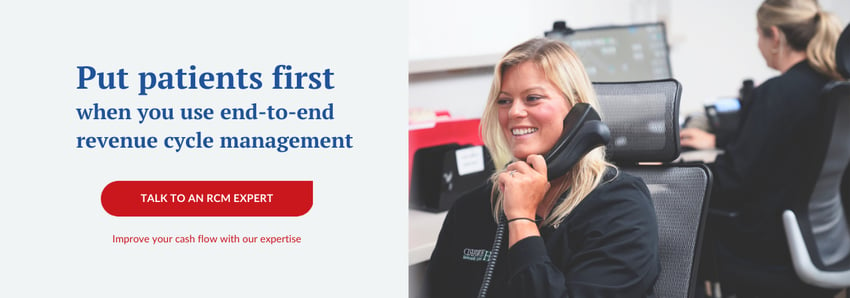3 steps to explain dental insurance coverage to a patient successfully


Have you ever wondered what the best strategy is to explain dental insurance coverage to a patient? Ideally, patients understand their own coverage, but we know this isn’t always the case. So it falls to your dental team to explain dental insurance coverage to patients. But what’s the best way to do this?
As a dental billing partner, Dental ClaimSupport is hyper-focused on helping you get easy insurance claims income. Because of our claims experience, we’re huge proponents of “inform before you perform.” This means you make sure to explain the procedure, appointments necessary, the total fee, and how their insurance may help them with their estimated insurance payment.
It is important that you understand your patients’ dental insurance coverage before you perform their treatment. This way, you are confident when presenting your treatment plan and financial arrangement and you will be able to collect their estimated portion in full.
In this article, we will share 3 steps to successfully explain dental insurance coverage to patients. By following these steps, you will be able to have a real conversation with each of your patients about what their estimated out-of-pocket amount is going to look like.
When there is transparency about what the fee is and what their estimated copayment is going to be, patients are faced with fewer surprise bills. This leads to more success when collecting from patients. In other words, more money for your practice, and better relationships with your patients.
Step 1: Obtain a breakdown of benefits for a reference
The first thing you need to do is gather the patient’s insurance information. This was ideally completed when they initially made their appointment and then you performed their insurance verification as soon as possible or at least 2 to 3 days prior to their scheduled appointment.
Once you’ve gathered their information and are able to log into their insurance portal, you’ll be able to obtain a full breakdown of their specific insurance plan. Use this time to understand what their benefits are and what kind of coverage they will be looking at.
Be sure to have a checklist that has all of the details about:
- Plan coverage percentage
- Maximum allowance (maximum used/ remaining)
- Benefit year
- Date of eligibility
- In or out-of-network coverage, based on a fee schedule or UCR.
Then you can review the other details such as missing tooth clause, waiting periods, LEAT (least expensive alternative treatment), implant coverage, etc.
Read through their fine print as well. Pro tip - remind your patient that no matter what their insurance covers, they are technically responsible for your full fee. Whatever that fee is, this needs to be the first number they see so that they can be prepared to pay it (if their insurance ends up not covering as much as they might think).
But before you have this conversation, you need to make sure it’s in the correct setting. After you’ve collected the patient’s insurance information, you’re going to have a conversation with them. Let’s get into it.
Step 2: Sit in a consultation room with your patient
We realize not every dental practice has a consultation room, but ideally, you will be able to sit somewhere, one-on-one with your patients, knee to knee, or stand eye to eye at a desk. If you do not have an area to discuss the treatment plan and make the financial arrangements, you may use the treatment room.
However, you should never have any discussions with the patient reclined in the chair as this may make the patient feel uneasy and overwhelmed. This is because the topic of money can be sensitive.
If your patient becomes stressed about the numbers they begin seeing, you can have a conversation about payment plans, if that’s something you offer. When you have this conversation in private, it gives your patients the opportunity to be honest about their ability to pay for their treatment, and for you to have a real discussion about it.
Next, figure out what their understanding of their insurance coverage is and go from there. You can then explain their estimated benefits based on the information you discover on the insurance portal. After explaining what you know to be true about their benefits you should always explain that there is no guarantee that insurance will pay and the payment is ultimately their responsibility.
You can refer to your practice management software during this conversation
Many teams will use their practice management software because it groups the treatment plan by appointment or as a total. These treatment plans usually list the details of the treatment, teeth numbers, the full practice fee, the estimated insurance payment, and the patient’s estimated payment.
There is usually a place where you can customize a disclaimer that this is an estimate only and the patient may be responsible for any additional treatment necessary or any difference the insurance didn't pay. There is also a place where the patient can sign to verify that the financial arrangements were made and that this is an estimate only.
Let’s get more into the details of their plan and their method of payment.
Step 3: Dive into the details of their plan and your payment protocol
As you get into the numbers with your patient and let them know the percentage of the treatment their insurance will likely cover according to their plan, remind them that this is an estimate. There is no guarantee of the precise cost of what insurance will or will not cover.
Has the patient seen a dentist or specialist recently? Let’s say you contacted their insurance company, and the patient has a $50 deductible that hasn’t been met. Maybe they saw a specialist recently and the deductible just hasn’t been processed yet. Details like this need to be addressed upfront. How recently their benefits have been used can affect their cost.
Go through the percentage of what their insurance plan covers for their preventative or restorative treatment. There’s definitely a difference between the two. If they have maxed out on benefits for the year, there might need to be a conversation about when their treatment is completed, but it likely still needs to be completed ASAP to prevent any damage (even if it’s just a simple filling).
Next, get into your financial policy. Explain your payment options, whether it’s through an online payment portal or at the front desk right after their treatment. List your accepted methods of payment (cash, credit card, checks, etc). And if you have a financing option, explain that as well.
Let your patient know that if the insurance doesn’t pay as estimated, they will either be reimbursed or billed. All patients should be given a walkout slip at the date of service and payment and they will receive an EOB from their insurance carrier that outlines exactly what their insurance did cover.
And of course, if they have any questions, they can feel free to reach out to you.
Want more tips for collecting successfully from your dental patients?
Educating your patients on their insurance coverage can go a long way with how smooth your patient billing process goes, and how happy your patients are with their dental treatment. When patients understand why their treatment costs what it does, they are less likely to put up any kind of fight about it.
Dental ClaimSupport wants dental teams to be successful in collecting from both dental patients and insurance claims. You’ll notice more consistent cash flow when you work with a trustworthy dental billing partner like DCS.
To learn more tips on how to collect successfully from your dental patients, visit our Learning Center.
Related Posts
Dental revenue resources from Dental Claim Support


